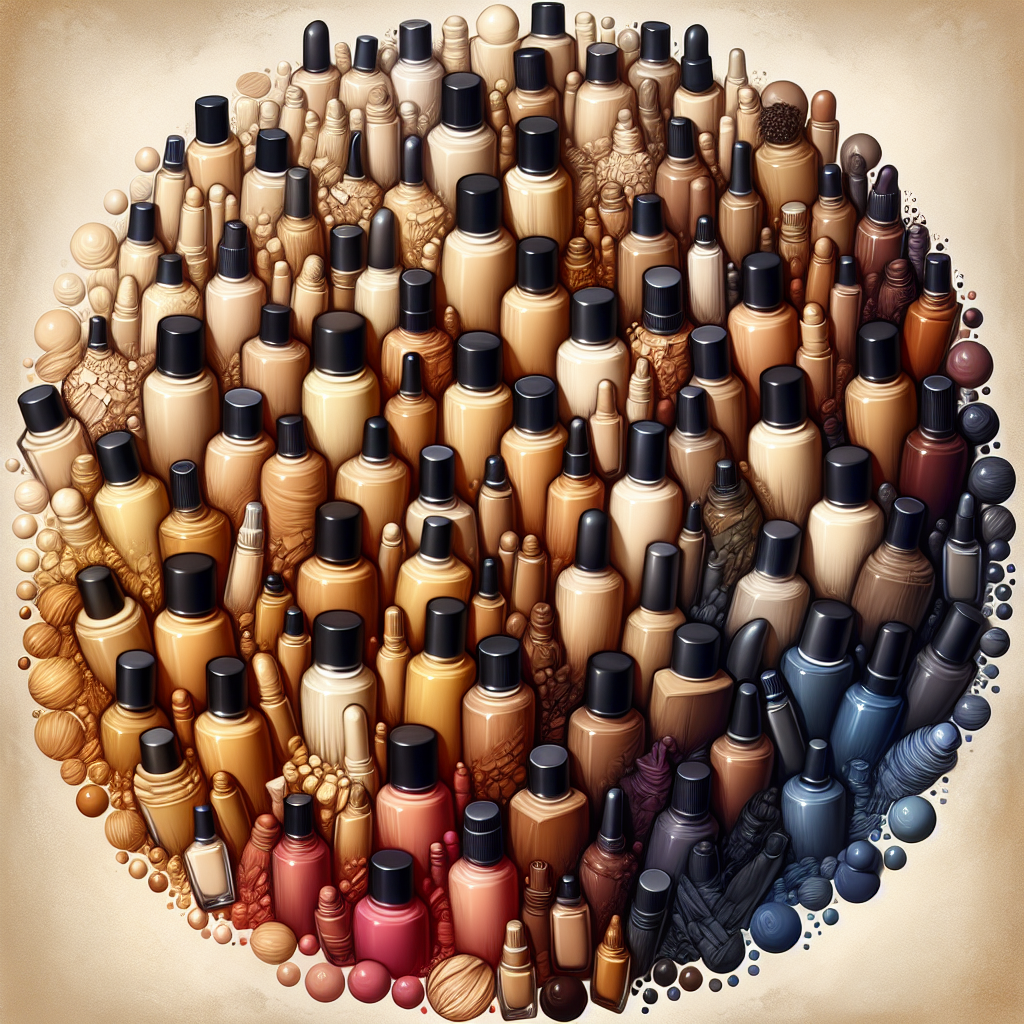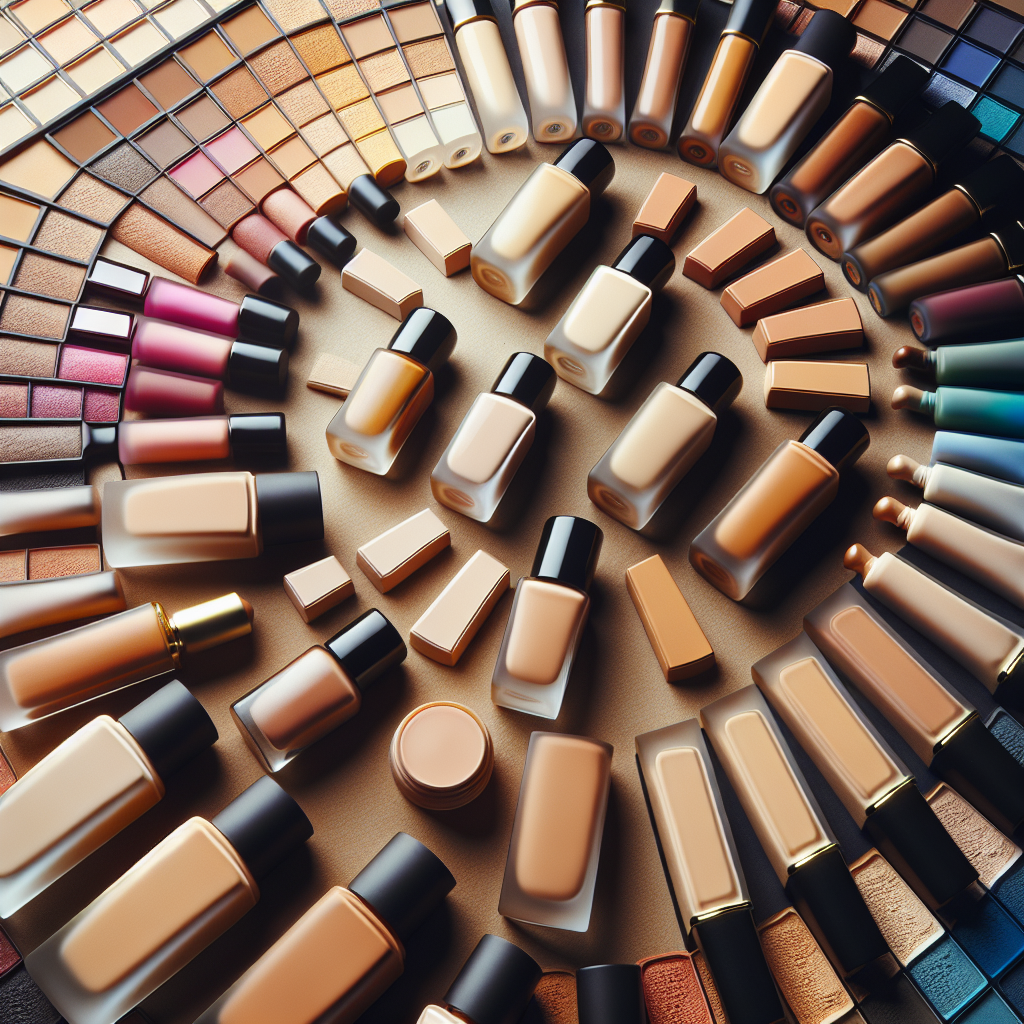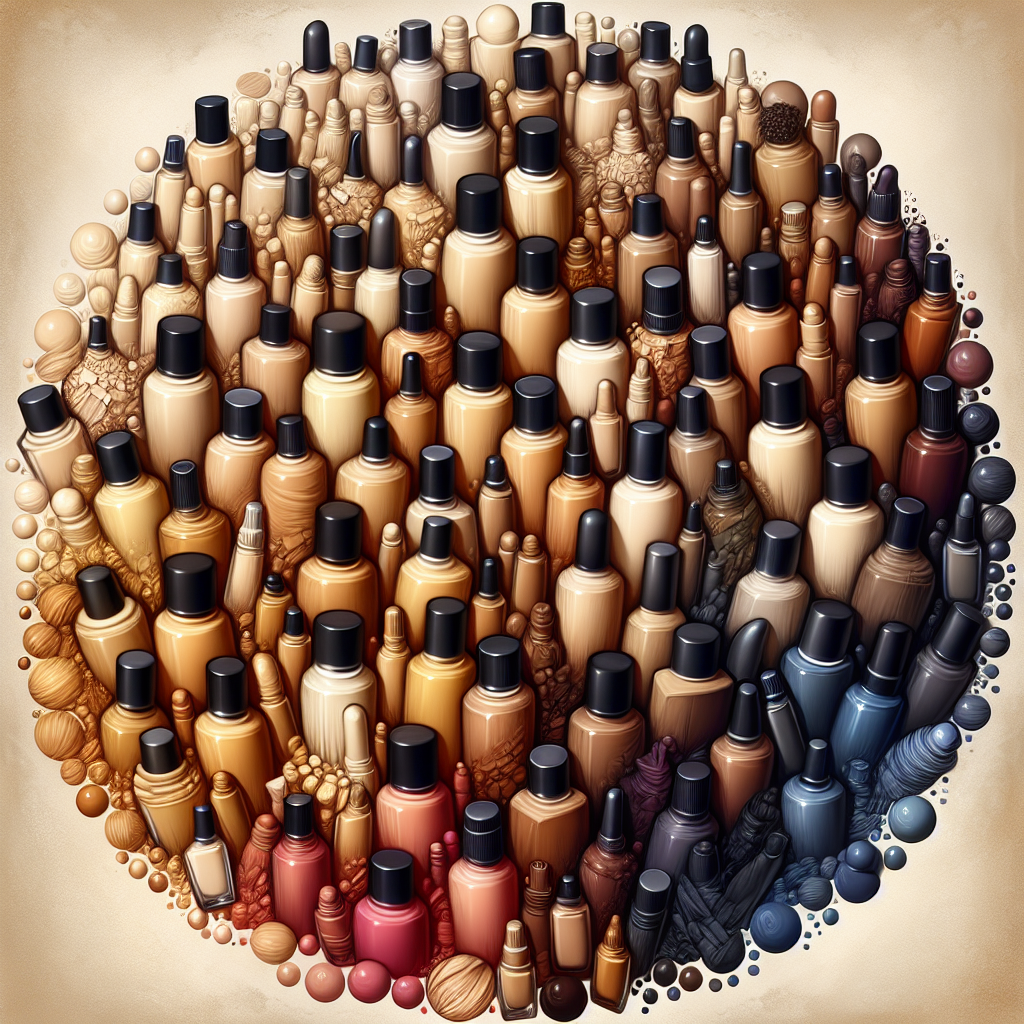Finding the perfect foundation shade for your skin tone can often feel like an overwhelming task. With countless options available, it’s easy to get lost in a sea of shades that may or may not suit your complexion. However, fear not! In this article, we will guide you through a simple and foolproof process that will help you choose the ideal foundation shade for your unique skin tone. Prepare to say goodbye to mismatched foundations and hello to a flawless complexion with the right foundation shade.
Understanding Your Skin Tone
Having a clear understanding of your skin tone is essential when it comes to choosing the right foundation shade. Your skin tone refers to the overall color and hue of your skin, while undertone refers to the subtle hues that lie beneath the surface. Determining your undertone and identifying your skin tone are the first steps in finding your perfect foundation match.
Determining your undertone
To determine your undertone, you can look at the veins on your wrist. If they appear blue or purple, you likely have cool undertones. Greenish veins indicate warm undertones, while veins that appear blue-green suggest neutral undertones.
Another method is to hold up gold and silver jewelry to your skin. If gold complements your complexion, you likely have warm undertones. If silver looks more flattering, you likely have cool undertones. If both gold and silver enhance your skin, you likely have neutral undertones.
Identifying your skin tone
Once you’ve determined your undertone, it’s time to identify your skin tone. There are several categories that can help you pinpoint where your skin falls on the spectrum. Fair skin is light and often burns easily in the sun. Light skin has a bit more warmth and may tan lightly. Medium skin has a natural tan or olive complexion. Olive skin has a green or gray undertone and tans easily. Dark skin is deeply pigmented, and deep dark skin is the darkest shade with rich undertones.
Understanding color temperature
Understanding color temperature is crucial in finding the right foundation match. Foundations are often labeled with terms like “cool,” “warm,” or “neutral.” Cool foundations have a pink or blue undertone and work best for individuals with cool undertones. Warm foundations have a yellow or golden undertone and are suitable for those with warm undertones. Neutral foundations have a balance of warm and cool undertones, making them versatile for individuals with neutral undertones.
Matching Undertones
Once you have determined your undertone, you can narrow down your foundation options to those that will complement your skin’s undertones. Understanding how undertones interact with foundation shades will help you choose a flattering and seamless match.
Cool undertones
If you have cool undertones, look for foundation shades with a pink or blue undertone. These cooler shades will help balance out any natural redness in your skin and create a harmonious look. Avoid foundations with yellow or golden undertones, as they may clash with your cool undertones and appear unflattering.
Warm undertones
For those with warm undertones, opt for foundation shades with yellow or golden undertones. These warm shades will enhance your skin’s natural warmth and provide a beautiful, sun-kissed appearance. Steer clear of foundations with pink or blue undertones, as they may make your skin appear sallow or ashy.
Neutral undertones
Neutral undertones offer more flexibility when it comes to foundation shades. You can experiment with both cool and warm undertones to find the perfect match. Neutral foundations with a balance of warm and cool undertones will seamlessly blend with your skin, creating a natural and flattering look.

Identifying Your Skin Tone
Now that you have determined your undertone and understand the different undertones and their corresponding foundation shades, it’s time to identify your skin tone. Knowing your skin tone will further narrow down your foundation options and help you find the ideal shade for a flawless complexion.
Fair skin
If you have fair skin, your complexion is lighter and may burn easily in the sun. When choosing foundation, opt for shades that provide light coverage and have a fair or porcelain undertone. Avoid shades that are too dark or have heavy coverage, as they can appear noticeably different from the rest of your skin.
Light skin
Light skin tones have a bit more warmth than fair skin and may tan lightly. Look for foundation shades that match your undertone, whether it’s cool, warm, or neutral. Consider shades with light to medium coverage to enhance your natural complexion without overpowering it.
Medium skin
Medium skin tones have a natural tan or olive complexion. Foundation shades with warm undertones and medium coverage will complement your skin beautifully. Avoid shades that are too light or too dark, as they may create a stark contrast with your skin tone.
Olive skin
Olive skin tones have a distinct green or gray undertone and can tan easily. Choose foundation shades with warm undertones and medium to full coverage. Look for foundations that specifically cater to olive undertones to ensure a seamless blend with your skin.
Dark skin
Dark skin tones have rich pigmentation and can range from warm to cool undertones. Opt for foundation shades that cater to your specific undertone, whether it’s warm, cool, or neutral. Consider shades with full coverage to create an even and flawless complexion.
Deep dark skin
Deep dark skin is the darkest shade with rich undertones. Look for foundation shades with deep pigments that complement your undertone. Full coverage foundations will provide the necessary opacity to even out your skin tone and create a beautiful finish.
Choosing the Right Foundation Formula
Aside from finding the perfect shade, it’s important to consider the foundation formula that best suits your skin type and provides the desired coverage. Understanding different foundation formulas, considering your skin type, and exploring coverage options will ensure a foundation that looks and feels incredible on your skin.
Understanding different foundation formulas
There are various foundation formulas available, each offering unique benefits and finishes. Liquid foundations are versatile and provide medium to full coverage. They are suitable for most skin types and offer a natural, skin-like finish. Cream foundations are thicker in consistency and provide buildable coverage. They work best for drier skin types and offer a more matte finish. Powder foundations are lightweight and provide sheer to medium coverage. They are ideal for oily or combination skin types and offer a matte finish.
Consider your skin type
Knowing your skin type is crucial in selecting the right foundation formula. If you have dry skin, opt for moisturizing liquid or cream foundations that provide hydration and a radiant finish. For oily or combination skin, oil-free liquid or powder foundations can help control shine and provide a matte finish. If you have sensitive skin, look for foundations that are fragrance-free and hypoallergenic to avoid any possible irritations.
Coverage options
The level of coverage you desire is another factor to consider when choosing a foundation formula. If you prefer a natural look with minimal coverage, opting for a sheer or light coverage foundation will provide a more radiant and fresh-faced appearance. If you require more coverage to conceal blemishes or imperfections, medium to full coverage foundations will offer a flawless finish. Keep in mind that the coverage can be built up by layering the foundation or using a concealer for targeted areas.

Testing Foundation Shades
Once you have narrowed down your options based on undertone, skin tone, and desired formula, it’s time to test foundation shades to find your perfect match. Testing on your jawline, trying multiple shades, and observing in natural light are essential steps to ensure an accurate foundation match.
Testing on your jawline
The jawline is the ideal area to test foundation shades as it is close to the neck and chest, which should have a similar undertone to your face. Apply a small amount of foundation to your jawline and blend it out. Observe the shade in natural light to see if it seamlessly matches your skin tone. Avoid testing the foundation on your wrist or hand, as these areas may not accurately represent the color of your face.
Trying multiple shades
It’s always a good idea to try multiple foundation shades to find the best match. Foundations can oxidize or change color once applied, so it’s essential to test a few shades to see how they settle on your skin. Select a few shades that closely match your undertone and test them side by side on your jawline. Compare how each shade looks in natural light and choose the one that blends seamlessly with your skin.
Observing in natural light
Natural light is the most accurate lighting to observe foundation shades. Indoor lighting can alter the appearance of colors, so stepping outside or near a window will give you a true representation of how the foundation looks on your skin. Take a mirror and go outside to observe how the foundation looks in different lighting conditions. This will ensure that you choose a shade that looks natural and flattering in all settings.
Consider Your Specific Concerns
When choosing a foundation, it’s important to consider any specific concerns you may have regarding your skin. Whether it’s concealing blemishes, minimizing redness, brightening dull skin, or addressing under-eye circles, certain foundation properties can help address these concerns effectively.
Concealing blemishes
If you have blemishes or acne-prone skin, look for foundations with high coverage that can effectively conceal imperfections. Matte or oil-free foundations can help control shine and minimize the appearance of blemishes. Consider formulas with salicylic acid or other acne-fighting ingredients to help improve the condition of your skin while providing coverage.
Minimizing redness
For individuals with redness or rosacea, opt for foundations with a green or yellow undertone. These color-correcting shades can neutralize redness and create a more even complexion. Look for foundations with buildable coverage that can be layered to achieve the desired level of redness reduction.
Brightening dull skin
If your skin looks dull or lacks radiance, consider foundations with illuminating or dewy finishes. These formulas contain light-reflecting particles that can add a subtle glow to your complexion. Look for foundations with hydrating ingredients like hyaluronic acid or vitamin C that can help brighten the skin and improve overall radiance.
Addressing under-eye circles
To camouflage under-eye circles, opt for foundations with a slightly lighter shade than your overall foundation match. These lighter shades can help brighten and correct the darkness under your eyes. Consider foundations with light-reflecting particles or ingredients like caffeine that can help diminish the appearance of under-eye circles.
Additional considerations
If you have specific skin concerns such as dryness, oiliness, fine lines, or large pores, consider foundations that cater to these issues. Look for moisturizing formulas with ingredients like glycerin or hyaluronic acid for dry skin. For oily skin, oil-free or mattifying foundations can help control shine. Consider foundations with blurring or smoothing properties to minimize the appearance of fine lines and pores.

Ask for Professional Assistance
Sometimes, finding the perfect foundation match can be a daunting task. If you’re unsure or overwhelmed, don’t hesitate to seek professional assistance. Makeup artists and beauty consultants are trained to analyze skin tones and recommend the best foundation shades for individual needs.
Consulting with a makeup artist
Makeup artists have extensive knowledge and experience in matching foundation shades to various skin tones. They can assess your undertone, skin tone, and specific concerns to recommend the best foundation options. Schedule a consultation with a makeup artist who can assist you in finding your perfect match and provide additional tips and tricks for application.
Visiting a beauty counter
Beauty counters at cosmetic stores or department stores often have trained beauty consultants who can assist you in finding the right foundation shade. These professionals can provide personalized recommendations based on your skin type and concerns. They can also offer samples or demonstrations to help you make an informed decision.
Seeking shade recommendations
If you prefer to shop online or cannot access in-person assistance, consider reaching out to brands or beauty experts for shade recommendations. Many brands have customer service representatives who can guide you toward the most suitable foundation shades based on your provided information. They can also answer any specific questions you may have regarding undertones, skin tone, or formula selection.
Consider Online Tools and Apps
In today’s digital age, online tools and apps can be incredibly helpful in finding your perfect foundation shade. These resources utilize advanced technology to analyze your skin tone and provide accurate shade recommendations.
Using online shade finders
Many beauty brands have online shade finders on their websites. These tools typically require you to input information about your undertone, skin tone, and specific concerns. Based on this information, the shade finder will generate a list of recommended foundation shades. While these tools can be a helpful starting point, it’s still essential to test the recommended shades in person or observe them in natural light to ensure a proper match.
Virtual try-on technologies
Virtual try-on technologies have become increasingly popular in the beauty industry. These innovative tools allow you to virtually try on different foundation shades using your smartphone or computer camera. Simply upload a photo or use the live camera function to see how each shade looks on your skin. While virtual try-on technologies are convenient, keep in mind that lighting and screen resolution can affect the accuracy of the shades.
Understanding Swatch Selection
When swatching foundations, it’s important to understand the nuances of selecting the right shade family, comparing swatches, and considering color adjusters. These factors can make the swatching process more effective and help you find your ideal foundation match.
Choosing the right shade family
Foundation shades are often categorized into different families, such as fair, light, medium, tan, and deep. While these broad categories can be a helpful starting point, it’s important to consider the undertones within each shade family. Look for undertone indicators such as “C” for cool, “W” for warm, or “N” for neutral to ensure a better match. Choosing the right shade family based on your undertone will greatly narrow down your options and make the swatching process more efficient.
Comparing swatches
When swatching foundations, it’s helpful to compare multiple shades side by side. Apply a strip of each shade to your jawline or forearm and observe how they appear in natural light. Pay attention to any variations in undertones or shades to find the closest match to your skin. Remember that foundations can oxidize, so it’s important to observe the swatches for a few minutes to see if they change color upon drying.
Considering color adjusters
Color adjusters can be a useful tool in customizing foundation shades to better match your skin. These products are often available in the form of drops or mixers and can be used to alter the undertone or shade of a foundation. If you are struggling to find the perfect match, consider incorporating color adjusters into your routine. Yellow adjusters can warm up a foundation that is too cool-toned, while blue adjusters can cool down a foundation that is too warm-toned.
Customizing Foundations
Sometimes, even with a wide range of foundations available, it can be challenging to find the exact shade and undertone that perfectly match your skin. In such cases, customizing foundations can be a game-changer.
Mixing foundation shades
If you can’t find a foundation that matches your undertone exactly, consider mixing different shades to create a custom blend. Start with a foundation that is closest to your undertone and gradually mix in small amounts of different shades until you achieve the desired match. Use a clean palette or the back of your hand to mix the foundations and apply the custom blend to your skin.
Adjusting undertones
If you have the right shade but the undertone is slightly off, you can adjust it using color adjusters. Add drops of a yellow or blue adjuster to warm up or cool down the foundation, respectively. Start with a small amount and gradually add more until you achieve the desired undertone. Mix the foundation with the adjuster thoroughly to ensure an even distribution of color.
By understanding your undertone, identifying your skin tone, considering formula options, testing shades, addressing specific concerns, seeking professional assistance, utilizing online tools, understanding swatch selection, and customizing foundations, you can confidently choose the right foundation shade for your skin tone. With the perfect foundation match, you can achieve a flawless complexion that enhances your natural beauty.





